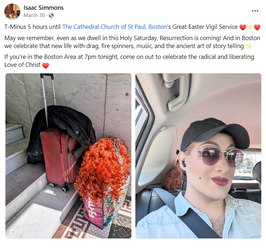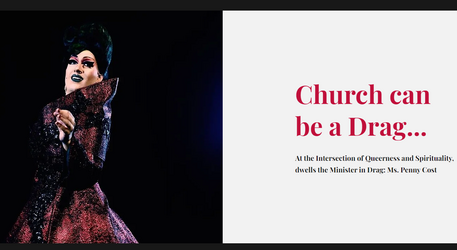- Joined
- Apr 6, 2019
If you belong to TEC when the Anglican Ordinariate and Western Rite Orthodoxy exist, you get what you asked for and furthermore, what you deserve.Episcopal Diocese of Massachusetts
Rev. Tamra Tucker


This dyke can play dress up all she wants, she will never be a real priest, and every "liturgy" she presides over is a demonic farce. That golden heifer of a drag queen is actually a great addition- it clears up any confusion about what is going on and who is being worshiped.


"Ms. Penny Cost"

All About Ms. Penny Cost
From the Closet to the Stage
Ms. Penny Cost wasn't always the Church Potluck Queen she is today! It was only in high school, after her first boyfriend invited her to church, that she even became religious. While undergoing the process of coming out, while losing connection with family members, while floundering through high school and thinking she would never be enough, she found something new... She found a church that told her a message that would stick with her for the rest of her life, "No matter who you are or what you have done, You, right here and now, are enough... this is all you will ever have to be".
Feeling energized by the Divine, and because she is a nerd at heart, Penny (as Isaac Simmons, her alter ego) dived deep into the study of faith, explored the discourse of theology, and discovered the sins of the Church's history... and yet, she found a light of hope. In her studies, she stumbled upon United Methodist Doctrine: a beautiful understanding of Grace, a history of reformation, and a desire to right the wrongs of injustice, oppression, and exclusion.
Penny fell in love with the United Methodist Church. It became her home. When Isaac announced his calling to Ordained Ministry, his home church, Hope United Methodist Church, celebrated and encouraged his discernment. Isaac Simmons and by extension, Ms. Penny Cost, became one of the first and few openly Queer persons to be certified as a Candidate for Ordained ministry within the Illinois Great Rivers Conference of the UMC, and reportedly, the first Drag queen to receive that tittle in the World.
Her Drag is rooted in the joy filled reclamation of Spirituality for and with Queer folks. Her mission is to break down the false duality which, for too long, has stated that Queerness and Faith can not be combined. She is here to say that YOU, right here and right now, are enough. There is nothing that you will ever have to do to experience the Love, Affirmation and Celebration which ever flows from the Divine.



